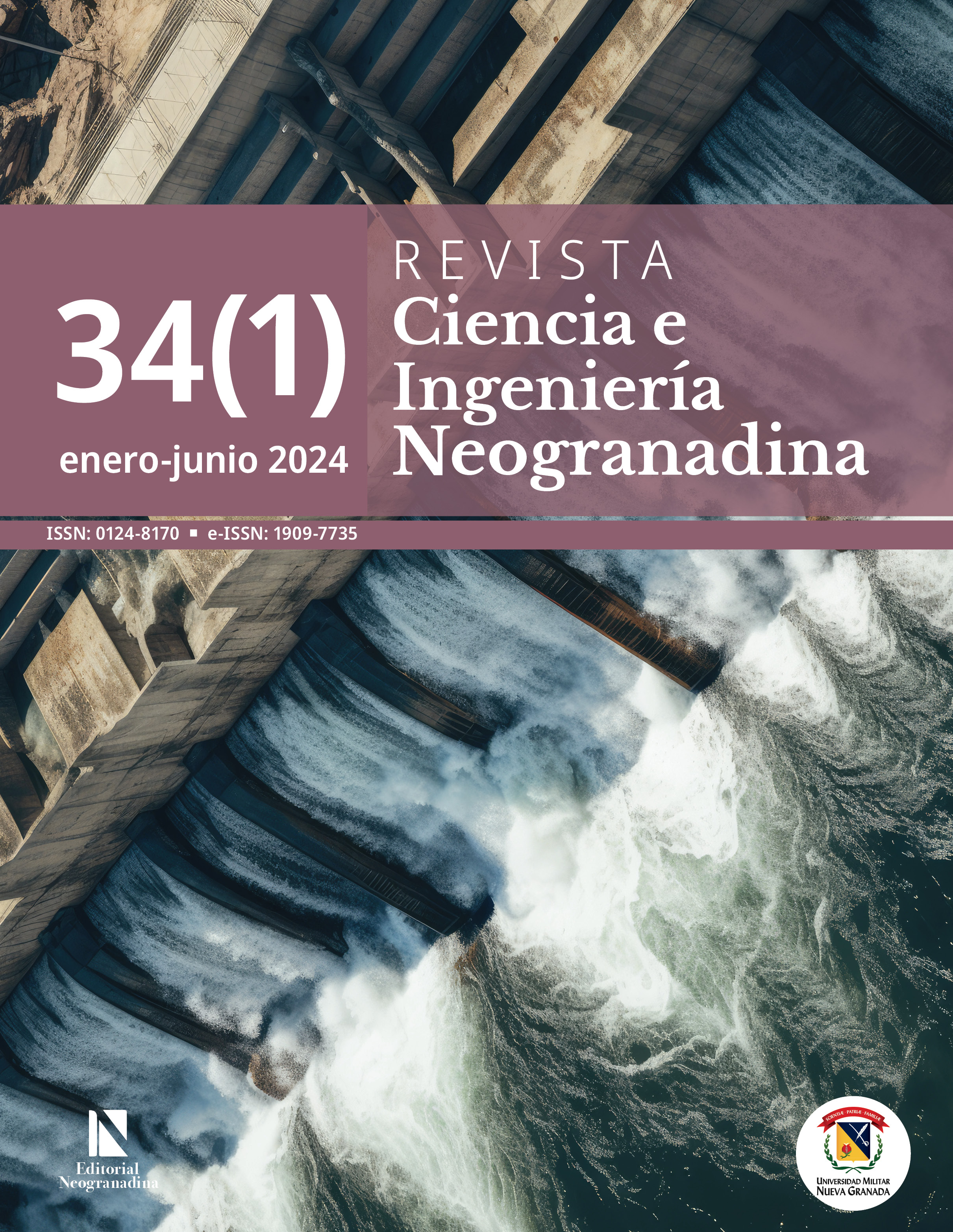Flooding Hazard Due to Waterlogging In The Aranda Expansion Area - Pasto, Nariño
Abstract
This study investigates the flooding hazard caused by waterlogging in the Aranda expansion zone of Pasto municipality, utilizing a critical design rainfall with a return period of 100 years. The hydrological conditions of the study area were delineated by defining the basin belonging to the Aranda expansion zone, corresponding to the El Blanco micro-watershed. Maximum precipitation data from three meteorological stations were employed to determine precipitation intensities for various durations based on the IDF curves. The MIKE SHE software simulated surface flow depths and velocities across the study area, considering land cover, soil hydrological characteristics, infiltration, slope, and calculated rainfall intensities. Flood hazard zoning, employing FEMA and IDIGER methodologies, revealed that steep slope areas exhibited a medium flood hazard due to the potential for flash flooding. Although the initial focus was on waterlogging in the expansion zone of the basin plain, the results indicated that the topographic conditions, characterized by steep slopes with high run-off velocities, warranted assigning a medium hazard level to these regions due to their heightened susceptibility to flash flooding. However, most of the micro-watershed demonstrated a low threat of flooding due to waterlogging, attributed to deep, well-drained soils facilitating infiltration and temporary water storage, thereby reducing surface water accumulation. These findings underscore the significance of considering hydrological characteristics in planning for this area, particularly within El Blanco micro-watershed.
Downloads
References
S. M. Abuzied and B. M. Mansour, “Geospatial hazard modeling for the delineation of flash flood-prone zones in Wadi Dahab basin, Egypt”, Journal of Hydroinformatics, vol. 21, n.° 1, pp. 180-206, 2019, https://doi.org/10.2166/hydro.2018.043
T. G. Asfaha, et al., “Determinants of peak discharge in steep mountain catchments – Case of the Rift
Valley escarpment of Northern Ethiopia”, Journal of Hydrology, vol. 529, pp. 1725-1739, 2015, https://doi.org/10.1016/j.jhydrol.2015.08.013
V. Aschonitis, et al., “Correcting Thornthwaite potential evapotranspiration using a global grid of local
coefficients to support temperature-based estimations of reference evapotranspiration and aridity indices”,
Earth System Science Data, vol. 14, pp. 163-167, 2022, https://doi.org/10.5194/essd-14-163-2022
G. D. Bathrellos, et al., “Urban flood hazard assessment in the basin of Athens Metropolitan city, Gree-
ce”, Environmental Earth Sciences, vol. 75, 2016, https://doi.org/10.1007/s12665-015-5157-1
S. Bond, et al., “Seasonal vegetation and management influence overland flow velocity and rough-
ness in upland grasslands”, Hydrological Processes, vol. 34, pp. 3777-3791, 2020, https://doi.org/10.1002/hyp.13842
Z. Cai, et al., Influence of vegetation coverage on hydraulic characteristics of overland flow. Water, vol. 13,
n.° 8, p. 1055, 2021, https://doi.org/10.3390/w13081055
C. L. Chen, “Rainfall Intensity-Duration-Frequency Formulas”, Journal of Hydraulic Engineering, vol. 109, p. 12, 1983. https://doi.org/10.1061/(ASCE)0733-9429(1983)109:12(1603)
V. T. Chow, D. R. Maidment y L. W. Mays, Hidrología aplicada, Bogotá: McGraw-Hill Interamericana, 1970.
J. Clayton, A fifteenth-century merchant in London and Kent: Thomas Walsingham, Tesis inédita MA,
Universidad de London, London, 2014.
C. Li, et al., “Hydrological response to climate and land use changes in the dry–warm valley of the upper
Yangtze River”, Engineering, vol. 19, pp. 24-39, 2022. https://doi.org/10.1016/j.eng.2021.04.029
C. A. Escalante Sandoval y L. Reyes Chávez, Técnicas estadísticas en hidrología, 2.a. ed., Ciudad de México,
México: Universidad Nacional Autónoma de México, 2005.
L. A. Esquea, et al., “Cambios en las coberturas de la tierra en el periodo 1984-2017 y análisis de la amena-
za ante inundaciones en el municipio de Campo de la Cruz, Atlántico, Colombia”, Revista de Ciencias, vol.
, n.° 2, 2020, https://doi.org/10.25100/rc.v23i2.9348
R. Gilbuena, et al., “Gap analysis of the flood management system in Metro Manila, Philippines: A case
study of the aftermath of Typhoon Ondoy”, IAHS-AISH Publication, vol. 357, pp. 32-40, 2013.
C. Gonzalo, Propuesta metodológica de modelización hidrometeorológica e hidrodinámica enfocada a la ordenación del riesgo de inundación: aplicación a la cuenca del río Pejibaye (Costa Rica). Tesis inédita
Ph. D., Facultad de Ingeniería, Departamento de Ingeniería Forestal, Universidad Politécnica de Madrid,
Madrid, 2011.
Ideam (2022). “Estudio Nacional del Agua 2022”. [Internet]. Disponible en https://www.andi.com.co/Uploads/Estudio%20Nacional%20del%20Agua%202022_compressed_638258123894912152.pdf
Ideam (2015). “Características climatológicas de ciudades principales y municipios turísticos”. [Internet]. Disponible en http://www.ideam.gov.co/documents/21021/418894/Características+de+Ciudades+Principales+y+Municipios+Turísticos.pdf/c3ca90c8-1072-434a-a235-91baee8c73fc
Instituto Geográfico Agustín Codazzi [IGAC] (2021). “Elaboración del mapa de cobertura de la tierra esca-
la 1:10.000”. [Internet]. Disponible en https://antiguo.igac.gov.co/sites/igac.gov.co/files/in-gag-pc07-03_ela-
boracion_del_mapa_de_cobertura_de_la_tierra_escala_110.000.pdf
N. Kazakis, I. Kougias and T. Patsialis, “Assessment of flood hazard areas at a regional scale using an in-
dex-based approach and Analytical Hierarchy Process: Application in Rhodope-Evros region, Greece”,
Science of The Total Environment, vol. 538, pp. 555-563, 2015, https://doi.org/10.1016/j.scitotenv.2015.08.055
Y. Kwak, and A. Kondoh, “A study on the extraction of multi-factor influencing floods from RS image and
GIS data; a case study in Nackdong basin, S. Korea”, The International Archives of the Photogrammetry, Re-
mote Sensing and Spatial Information Sciences, vol. 37, pp. 421-435, 2008.
N. N. Kourgialas and G. P. Karatzas, “Flood management and a GIS modelling method to assess flood-ha-
zard areas—a case study”, Hydrological Sciences Journal, vol. 56, pp. 212-225, 2011, https://doi.org/10.1080/02626667.2011.555836
R. Linsley, M. Kohler y J. Paulhus, Hidrología para ingenieros, 2.a. ed., Nueva York: McGraw-Hill, 1993.
C. Martínez, et al., “Modelling infiltration process, overland flow and sewer system interactions for ur-
ban flood mitigation”, Water 2021, vol. 13, n.° 15, 2021, https://doi.org/10.3390/w13152028
MIKE (2024). “User guide and reference manual”. [Internet]. Disponible en https://manuals.mikepowe-
redbydhi.help/latest/Water_Resources/MIKE_SHE_Print.pdf
UNGRD (2021). “Plan nacional de contingencia segunda temporada de lluvias”. [Internet]. Disponible en
https://portal.gestiondelriesgo.gov.co/Documents/PNC/PNC-2TEMPORADA-LLUVIAS-2021.pdf
X. Ren, et al., “Effect of infiltration rate changes inurban soils on stormwater runoff process”, Geoderma, vol. 363, 2020, https://doi.org/10.1016/j.geoderma.2019.114158
A. B. Rimba, et al., “Physical flood vulnerability mapping applying geospatial techniques in Okazaki City, Aichi Prefecture, Japan”, Urban Science, vol. 1, pp. 1-22, 2017, https://doi.org/10.3390/urbansci1010007
Secretaría de Planeación Municipal de Pasto (2023). “Plan Parcial Aranda Central” [Internet]. Disponible
U. B. Sezar and K. A. Cevza, “Investigation of overland flow by incorporating different infiltration methods into flood routing equations”, Urban Water Journal, vol. 17, 2020, https://doi.org/10.1080/1573062X.2020.1748206
D. Sun, D. Zhang, and X. Cheng, “Framework of national nonstructural measures for flash flood disaster
prevention in China”, Water, vol. 4, pp. 272-282, 2012, https://doi.org/10.3390/w4010272
R. Weingartner, M. Barben, and M. Spreafico, “Floods in mountain areas—an overview based on
examples from Switzerland”, Journal of Hydrology, vol. 282, pp. 10-24, 2003, https://doi.org/10.1016/S0022-1694(03)00249-X
X. Wu, et al., “An evaluation of the impacts of land surface modification, storm sewer development, and
rainfall variation on waterlogging risk in Shanghai”, Nat Hazards, vol. 63, pp. 305-323, 2012, https://doi.org/10.1007/s11069-012-0153-1
P. Yariyan, et al. Flood susceptibility mapping using an improved analytic network process with statistical
models. Geomatics, Natural Hazards and Risk, vol. 11, n.° 1, pp. 2282-2314, 2020, https://doi.org/10.1080/19475705.2020.1836036
Y. Zhou, et al., “Real-time prediction and ponding process early warning method at urban flood points
based on different deep learning methods”, Journal of Flood Risk Management, vol. 17, n.° 1, 2024, https://doi.org/10.1111/jfr3.12964
Federal Emergency Management Agency [FEMA] (2020). “Guidance for Flood Risk Analysis and Mapping” [Internet]. Disponible en https://www.fema.gov/sites/default/files/documents/fema_flood-risk-assessment-guidance.pdf
Instituto Distrital de Gestión del Riesgo y Cambio Climático [IDIGER] (2018). “Proyecto actualización
de componente de gestión del riesgo para la revisión ordinaria y actualización del Plan de Ordenamiento
Territorial” [Internet]. Disponible en https://www.sdp.gov.co/sites/default/files/4-DOCUMENTO-TECNICO-DE-SOPORTE/Gestion%20del%20Riesgo.%20Amenazas%20inundacion%20Urbano.pdf

Copyright (c) 2024 Ciencia e Ingenieria Neogranadina

This work is licensed under a Creative Commons Attribution-NonCommercial-NoDerivatives 4.0 International License.











